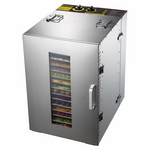
About Food Dehydrators
Food dehydrators are gradually transitioning from niche kitchen appliances to essential products for dedicated healthy eating. These benchtop units reduce the water content of fruits, vegetables, and meats, among other foods. In extracting moisture from food, you significantly increase its shelf life while retaining the bulk of nutrients. This allows you to prepare healthy snacks, cut down on waste, and potentially save money. Food dehydrators come in different shapes and capacities, and manufacturers are investing more in innovative drying technology. Use this buying guide to find the right dehydrator for your dietary needs.
How do food dehydrators work?
The common components of all food dehydrators are a heating element, a fan, and ventilation outlets. Your food will rest on stainless steel trays or stackable food-safe plastic racks. The heating element draws moisture from your food and the fan circulates the moist air towards the air vents, where it is expelled to ensure it doesn’t re-enter your food. The final product will be dry and shrivelled in appearance, but still brimming with nutritional value. There’s no need to involve preservatives or sugar, and you have the convenient option of dehydrating different types of food across multiple levels.
Westinghouse Dehydrator 600watt Stainless Steel WHDH01SK
Yet to be reviewed
Excalibur Stainless Steel Ten Tray Food Dehydrator EXC10EL
Yet to be reviewed
BioChef KT-DE-BC-KH-16T-AU Kalahari 16 Tray Food Dehydrator
Yet to be reviewed
BioChef Premium 16 Tray Food Dehydrator KT-DE-BC-PCOM-AU-SS
Yet to be reviewed
So what are the benefits?
Food lasts for longer
By reducing moisture levels in fruits, vegetables, and meats, dehydrators prevent bacteria from growing and spoiling food. If you bought a few too many apricots, dry what is left over for later consumption. In many cases, a food dehydrator can extend the shelf life of produce by up to two years.
Endless possibilities
You’re clear on the health benefits of food dehydrators, but what exactly can you make with one of these appliances? You can dry fruits such as cherries, peaches, and kiwi fruit and take them along as fuel for a long hike. You can make your own sweet potato fries without any oil, or dry tomatoes for use in a pasta dish. Make fruit roll-ups for your kids’ lunchboxes, or make beef jerky for your own afternoon snack. You can even use a dehydrator for non-food items—dry flowers for framing, or dry papier-mâché in craft projects.
Save money
The cost of store-bought dried fruit can add up over time if you eat it frequently. Buying your own fresh fruit and dehydrating it at home is a far more cost-effective option. For the ultimate in savvy spending, buy produce in bulk when it’s in season and dehydrate what’s left for use several months later. That is, you can enjoy ripe, juicy strawberries at the beginning of the year and use dehydrated strawberries to make jam in July.
Conserve storage space
When you dehydrate food, it shrinks to occupy less than one-sixth of its original space. For this reason, it may benefit a large family to own one of these appliances. Avid campers and hikers will also be pleased with this reduction in size, as it makes packing far more convenient. Dehydrated food doesn’t need a running power source to keep, so anything taking up fridge space can be transferred to the pantry.
Fuller flavour
When you remove moisture from food, its flavours become more concentrated. Not only is each bite more delicious; you consume the food with greater peace of mind knowing there is no added sugar, unlike many varieties of dried produce you would buy at the supermarket.
Features to look for
Horizontal drying
While dehydrators with stackable racks are championed for their compact footprints, you will often have to periodically rotate the racks for optimum drying. Horizontal trays allow for more uniform drying. No rotation is required, and you won’t be left with any icky moisture spots.
Thermostat control
An adjustable thermostat is essential if you’re going to be drying a wide range of foods. Those on a raw foods diet will benefit from drying at low temperatures and, if beef jerky is your favourite snack, you can turn up the heat for optimum results.
Timer
Purchasing a dehydrator with a timer opens up a whole world of set-and-forget convenience. You can begin drying food right before you go to bed or leave for work, safe in the knowledge the unit will automatically switch off when the program is complete.
Fruit roll tray
Fruit roll-ups or fruit leathers are popular lunchbox treats, but supermarket varieties are packed with sugar and bear a relation to fruit by flavour rather than content. Dehydrators with stackable trays sometimes come with an accessory that is tailored for making these delicious, healthy snacks.





